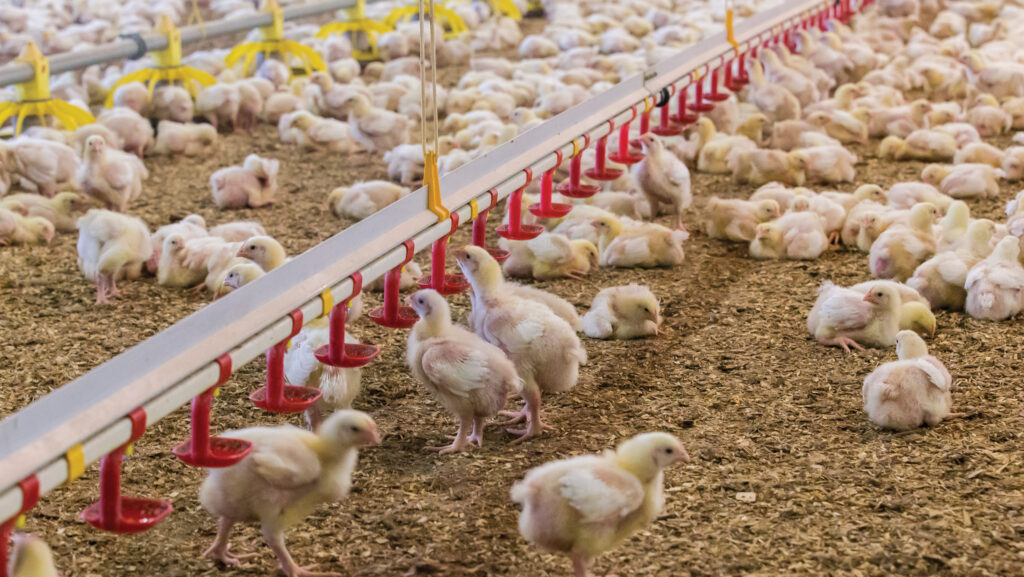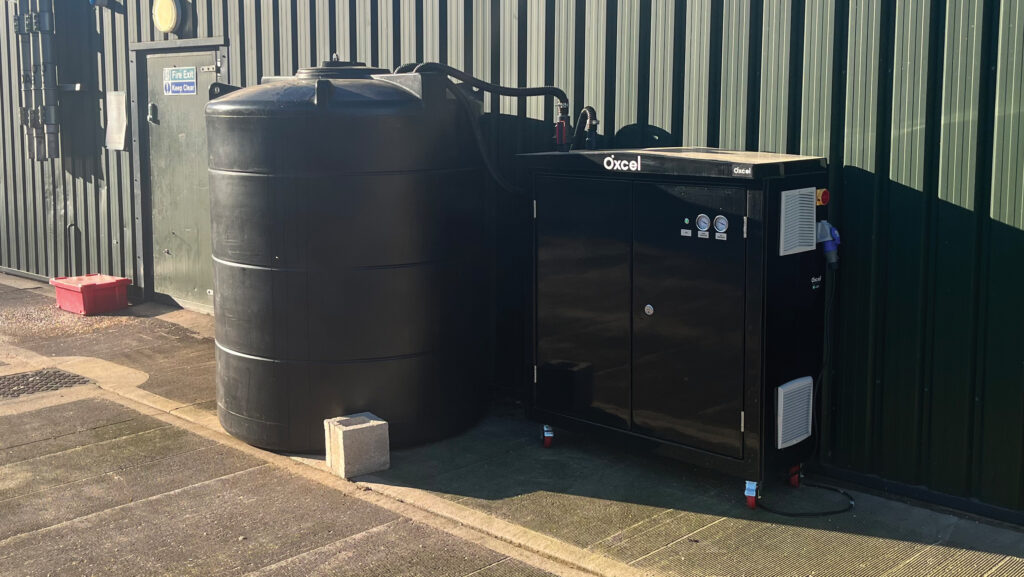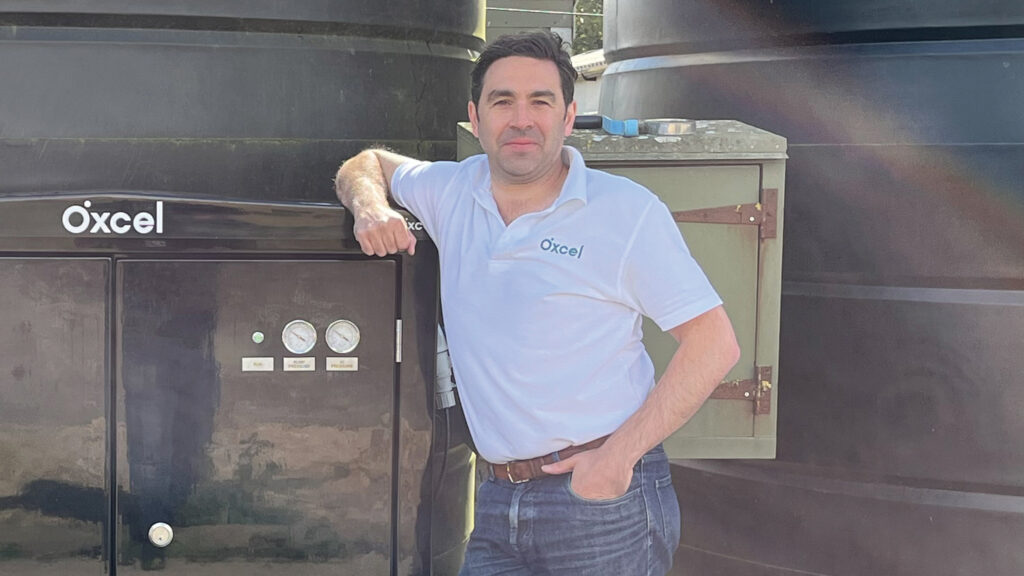Benefits of increasing water oxygen content for broilers
 © GNP
© GNP Technology to intensify water’s dissolved oxygen content has been shown to reduce mortality and improve performance in broiler systems.
A Ross 308 broiler trial, which involved 840 birds, showed 37.3% had no hock burn lesions compared with 12.3% of birds with access to standard tap water.
Agri-tech firm Oxcel, commissioned the study at Scotland’s Rural College (SRUC) in conjunction with UK Agri-Tech Centre, and is now rolling it out commercially.
See also: Advice on using water vaccination for broilers and layers
It says that using the technology to oxygenate water has produced very positive results.
The process is founded on science, but in simple terms it super hyperoxygenates water by introducing more than 214m tiny bubbles of medical-grade oxygen for every millilitre of oxygen in the water.

Water treatment to enhance oxygen levels is improving broiler health and performance © Oxcel
Oxygen content
The resulting water has an oxygen content that is between four and six times higher than that of standard water, which is good for poultry gut and overall health.
Every broiler unit that is Red Tractor Assured has a minimum 24-hour water supply backup.
It is this tank of water that is treated, using the existing infrastructure to distribute the nanobubbles. This means no changes are needed to on-farm systems.
The bubbles are stable in water for up to 120 days, unless they react with a contaminant; when this happens, larger particles will form, although these are removed by a built-in filtration system.
The main benefit to birds comes from the stable hyperoxygenation – even at the end of drinker lines, which can be up to 100m away from that tank.
Tap water at source contains 7-9mg/litre of oxygen, dropping to 4-6mg/litre at the drinkers because it reacts with biological actions and aeration on that journey.
Borehole water at the drinkers is lower than this, at about 3-4mg/litre.
“Putting this into perspective, fish need at least 5mg/litre to survive. Anything lower is effectively ‘dead’ water,’’ says Oxcel founder and chief executive Alex Leigh.
Nanobubble technology applied to any water provides 35-40mg/litre of oxygen in the storage tank, and 25-30mg/ml at the point of consumption – six times higher than standard levels on farms.

Alex Leigh © Oxcel
Broiler benefits
According to the trial results, in addition to fewer hock burn lesions:
- 17% more birds in the oxygenated group had a full feather coat
- 40% showed no signs of white striping, a form of meat myopathy
- 11.6% of birds had lower abdominal fat and 2.6% higher thigh yield in the treatment group.
Alex says all these improvements result in a more active and happier bird.
This is being seen in commercial-scale trials too.
“What we’re seeing on-farm matches the SRUC trials – the birds are more mobile and develop stronger legs, staying active even as they get heavier,” he says.
“We’re seeing far fewer cases of hock burn, pododermatitis and leg culls. It’s a simple change for the farmer, but it’s making a big difference.”
Throughout the SRUC trial, bird performance had remained robust, he adds.
DNA analysis of all of the bacteria present in the gut biome of the trial birds showed that the population was more diverse, which is key to improved digestion and immunity.
“We were able to show five key genes [in the bacteria] linked to activities such as protein breakdown and feather growth,” he says.
“So by creating a better gut biome, we are creating the conditions that are better for nutrient absorption and for health.
“We are not just seeing output indicators but the mechanisms of how that is working.”
However, for commercial producers there are limits.
Although scientifically validated and carried out in conditions intended to replicate those on commercial units, research farm conditions are optimal and the study only involved a small number of birds.
Even the birds in the group that received standard water exceeded breed targets by 20%.
Consequently, Alex and his team are testing the technology on large-scale broiler units with 100,000 birds or more.
This will provide further validation and give commercial growers confidence than it can deliver in those systems too.
Better mortality rates
“There are variables in farm situations that are not present in a research environment, but we have shown that we can typically take mortality rates down by 25%.
“In the average crop where mortality rates are typically 3-6%, we are taking it down by 1% in absolute terms, even by 2% in a challenged crop.’’
The commercial trials are also resulting in faster daily liveweight gains, fewer carcass rejections, improved leg health, lower hock burns and cleaner birds.
This creates a strong economic case for improving water supply on larger farms, Alex suggests.
“On a typical 160,000-bird farm, the net direct benefits translate to £45,000-£65,000/year before considering the meat quality and welfare benefits.’’
What is nanobubble technology?
Nanobubbles are used for cleaning lakes and ponds, treating waste water, and for crop production. But it is thought to be the first time this technology has been applied to poultry systems.
A laboratory trial in Korea showed nanobubbles to produce birds with a stronger immune system, with better feed conversion efficiency, and with a lower level of intramuscular fat.
This resulted in superior meat quality.
Catalyst for livestock
However, that study was small-scale and used bamboo shoots to create this effect, so it was not scalable beyond that proof of concept.
These findings were the catalyst to Oxcel recognising their potential if applied to bigger livestock units, specifically in intensive broiler and pig systems.
“A function designed specifically to work in a commercial farming environment was lacking.
“Oxcel was founded to commercialise that opportunity to work with engineers to develop a farm-specific application that can be integrated with no disruption to existing infrastructure,’’ says the firm’s founder Alex Leigh.
The firm was one of three to win a share of £2m Eastern England launchpad grant open to agri-tech and food technology with innovation projects.
In another trial involving pigs, Oxcel showed a £4.50-£9.50 a pig economic benefit through an improved feed conversion rate, better growth and reduced mortalities.
“Those financial benefits come from a significant reduction in what the animal needs to eat to get to market weight, and by increasing daily liveweight gain.
“So pigs are getting to market quicker, which means existing facilities can yield more output,’’ says Alex.
Commercial agreement
Its commercial application is based around a water as a service model.
This entails the company retaining ownership of the machine (which injects bubbles into the water) and the farmer committing to an agreement for a minimum of four years.
The service costs represent less than 25% of the direct economic benefit observed on-farm, says Alex.
“Farms see a payback within the first growth cycle – often in under two months – before considering gains in welfare, product quality and environmental impact.’’
The next step is to run trials with layer flocks, where gut health is integral to egg shell quality, cycle length and other key performance indicators
